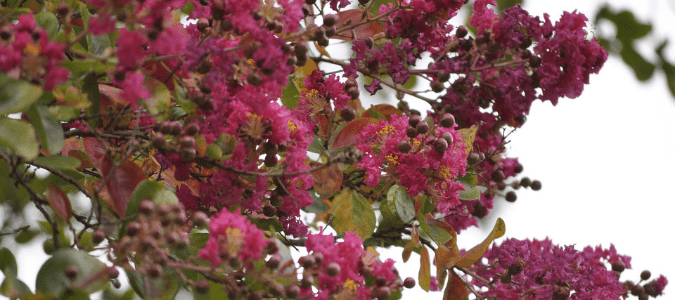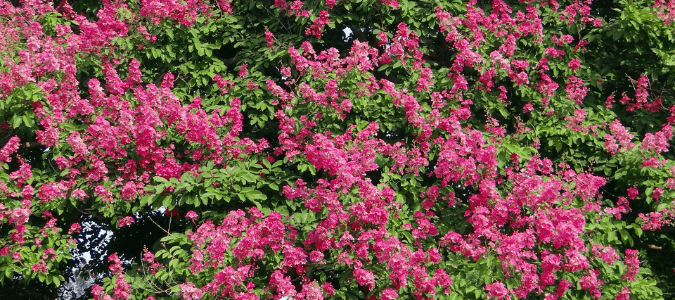Crape myrtles make a beautiful ornamental addition to any yard or garden. There are small, medium and large crape myrtle varieties that can fit almost any space or aesthetic. They boast delicate bloom clusters in colors ranging from white to pink, red, lavender or purple. Best of all, once established, they do just fine in hotter, drier areas without a lot of extra coddling. So when do crape myrtles bloom? They bloom during the hotter months, and can bloom again and again throughout summer.
Many types of crape myrtles bloom first in May, while others wait until mid-summer to show their first flowers. It depends on the type of crape myrtle, but other factors also come into play. Crape myrtles that are planted in too much shade won’t bloom as soon or as often. These trees do best in full sun. They also do well in partial shade. Crape myrtles in full shade might never bloom at all.
When to Prune
Once the blooms start to lose their vibrant color and fall off, you can lightly prune the tips of the branches to stimulate new growth. Crape myrtles bloom with new growth. This is why their flowers go dormant in fall, winter and early spring. Once warmer weather and rains return, the tree starts its new growth cycle for the year, and colorful flowers soon follow.
Pruning dead blooms does stimulate new growth, but it’s important not to cut crape myrtles back too severely. Some people believe cutting these trees way back creates more flowers, but this is not necessary. It can even harm the tree. Pruning too much can certainly stimulate new growth, but the new branches will be thin and weak. This means they are more likely to break, especially once they are weighed down by heavy flower clusters.
Light pruning, on the other hand, is a great way to keep your crape myrtles bursting with new flowers every month or two throughout summer and early fall. Another way to support a healthy, thriving crape myrtle that bursts with blooms is to give it the right fertilizer. Look for a slow-releasing product with a high proportion of phosphorus. Phosphorus is the P in the N-P-K ratio of nutrients listed on the bag.
For many people, learning how to trim a crape myrtle is confusing or too much work. The best and easiest method for caring for your crape myrtles is contacting a yard care professional. A licensed professional knows the right fertilizer to use and when, to support crape myrtles in their growth. A pro can also take care of periodic light pruning to promote the growth of new blooms.
If you are thinking about planting crape myrtles in your yard, a pro can help you choose the right variety for your space and aesthetic. They can also help you with design, including determining the best spot on your property for crape myrtles to bloom. Once the trees are planted, they can handle every aspect of ongoing care to ensure that your beautiful investments will thrive.
Crape Myrtle Not Budding? Here’s Why, and What to Do
One of the main reasons people love crape myrtles is because of their gorgeous, showy blooms. So when your crape myrtle is not budding, you may wonder what’s wrong, and what you can do about it. There are several different reasons why crape myrtles might not produce blooms. These can range from too little direct sunlight to unseasonably cool weather.
Crape myrtle blooms are actually big clusters made up of lots of small flowers. The flowers have tissue-thin, frilly petals that look somewhat like they’re made of crape paper. Crape myrtles have plenty of other assets, like how easy they are to grow and care for. Their leaves that turn beautiful colors in fall are another plus. But the pops of color their flowers provide are the real draw. That’s why it’s a real disappointment when your crape myrtle doesn’t bloom as expected.
Not Enough Sun?
The first thing to consider is how much sunlight your crape myrtle gets where it is planted. Crape myrtles prefer full sun. They produce the most flowers when they get a lot of sun every day—six hours or more of direct sunlight. Is your crape myrtle not budding because it isn’t getting enough sun?
If this is the case, there may not be much you can do about it. If the crape myrtle is a smaller, shrub variety that is in a pot, you can simply move it to a sunnier part of your yard. But many crape myrtles are planted in the ground and can’t be moved easily. If yours is shaded by other plants and trees, you can try pruning the plants around it enough to provide at least dappled sunlight. This should help the crape myrtle produce more blooms.
Another issue that can cause crape myrtles not to bloom as expected is pruning too soon after fresh growth. If you cut your crape myrtle back after it has shown new growth, you might be accidentally pruning away its buds before they have a chance to flower. It’s best to prune crape myrtles only lightly, and before they enter their springtime growth cycle. From late winter and into early spring is a safe time to prune crape myrtles. February is still a safe month for pruning, but March may be too late for pruning without reducing blooms.
It’s also possible that it’s simply too cool outside or too early in the season for your crape myrtle to bloom just yet. Some crape myrtles bloom as early as May. Others wait until June or even July for their first flower buds to pop out in full color. If the springtime is unusually cool one year, your crape myrtles will bloom later than they would in a warmer year. In this case, it’s just a matter of patience. Those blooms will pop when they’re ready.
Fertilizing your crape myrtles in late winter or early spring is a good way to support your trees. This will encourage them to produce new growth that will lead to new blooms in late spring or summer. You can even fertilize them as late as May or June for good effect. Just use a product that is higher in phosphorus than nitrogen, and don’t apply too much. Too much fertilizer can actually inhibit the crape myrtle’s health.
If your crape myrtles aren’t budding and you don’t know why, it’s a good idea to call in a lawn service professional who can inspect and identify the problem. If there is an issue, a pro can give you advice about a treatment plan. They can also schedule follow-up visits to ensure proper care of your crape myrtle to make sure it can bloom and thrive.
White Bugs on Crape Myrtle
If you see little white bugs on crape myrtle trees, what you’re seeing is crape myrtle bark scale. Also referred to as CMBS, these scale insects are small, fuzzy and white or gray in color. The females attach themselves to the crape myrtle’s bark, where they feed and then lay eggs. They lay hundreds of eggs at a time, which can quickly lead to a CMBS infestation within a single growing season.
These little bugs excrete something called honeydew—a sweet-sounding name for their feces. They leave this sticky, sweet liquid all over the crape myrtle’s bark. Its sweetness causes the growth of a dark-colored mold all over the parts of the bark where the insects spend time. (Aphids can also cause the growth of this same type of dark, sooty mold.)
Interestingly, crape myrtle bark scale is a relatively new problem in the U.S. These little scale insects have only been bothering crape myrtles in the United States since the early 2000s. Fortunately, CMBS and the related mold they cause don’t usually kill crape myrtles, and they are treatable. They do cause unsightly damage over time, though. If you spot CMBS on your crape myrtles, it’s time to make a treatment plan.
Treating for CMBS
A simple way to treat your crape myrtles for CMBS is to wash the trunk and any limbs that you can reach with a mixture of water and dish soap. You can use a soft brush to remove as many of the insects and as much of the mold as possible.
Applying systemic insecticides to the soil around the affected tree is even more effective. Keep in mind that it can be hard for the average home gardener to get rid of CMBS once these pests take over their crape myrtles. This is why it’s smart to call in a professional if you are dealing with this issue. A landscaping specialist can choose the right insecticide product and apply it correctly to your trees. They can return for follow-up visits to ensure the scale insects are decreasing and the health of the crape myrtle is improving.
It’s also smart to avoid CMBS from the start, if possible. If you buy crape myrtles from a garden store to plant on your property, be sure to look them over carefully before bringing them home. Check the bark all over for any signs of small, fuzzy insects, sticky residue that could be their waste excretions or spots of dark, sooty mold. If you see any of these signs of crape myrtle bark scale, look for a different plant that isn’t affected.
ABC Can Keep Your Crape Myrtles Looking Beautiful
There can be a lot involved with taking care of crape myrtles. For healthy, happy trees, contact ABC Home & Commercial Services. Our certified lawn service experts will ensure that your trees grow strong and beautiful.



